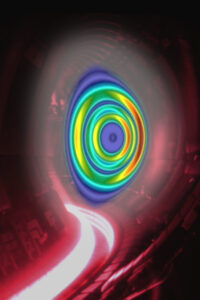Fusion energy promises to deliver safe, sustainable, and low-carbon baseload power, complementing other clean energy sources like solar and wind.
To reach optimal performance, fusion researchers need to manage unwanted turbulence in the hot plasma inside their tokamak machines. One important question is what happens when the fusion process starts releasing fast, heavy helium ions (alpha particles) into the plasma. Fast alpha particles can trigger instabilities in the plasma, which can then cause energy losses.

“Our goal was to study whether our earlier findings on turbulence reduction in tokamak plasmas with high-energy ions could be replicated in deuterium-tritium (D-T) plasmas, the primary fuel for the international ITER project and future fusion power plants”, explain Jeronimo Garcia (CEA-IRFM, France) and Yevgen Kazakov (LPP-ERM/KMS, Belgium), the leading authors of the Nature Communications paper.
Together with international colleagues, Garcia and Kazakov used the record-setting experimental campaign at JET in 2021 to get as close as they could to the so-called burning plasma conditions in ITER.
JET, which stopped operation in 2023, was the only tokamak in the world able to run on the high-performance deuterium-tritium fuel (D-T) that ITER and future machines will use. Deuterium and tritium are heavier variants (isotopes) or ordinary hydrogen, which together produce the most energetic fusion reactions possible in nature. They also release large amounts of alpha particles when they fuse.
Using a series of dedicated experiments, EUROfusion researchers successfully replicated the ITER plasma conditions at JET as closely as possible. That delivered a surprising outcome, recall the researchers.
“The performance and plasma parameters in D-T experiments was actually better than expected!”, says Garcia. “Remarkably, with tritium in the mix not only the core plasma conditions improved, but we also observed a new beneficial state at the edge of the plasma, without unwanted energy outbursts. Those are promising results for future fusion reactors.”
Kazakov adds that the researchers performed additional experiments in pure deuterium plasmas to isolate the effects of tritium and pinpoint the causes of these improved conditions. “We found fast ions significantly stabilise turbulence in the plasma when we have tritium as part of the fuel mix.”
The findings are excellent news for future magnetic fusion reactors, according to the researchers. “Our results demonstrate that the addition of heavier tritium ions has a calming effect on the plasma, reducing turbulence,” concludes Garcia. “The discovery of this new regime at JET could influence future reactor designs, potentially leading to smaller, more cost-effective machines.”
Reference
J. Garcia, Y. Kazakov et al., Nature Communications 15, 7846 (2024)
